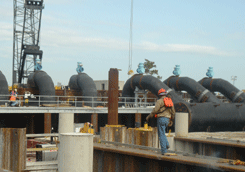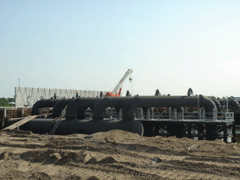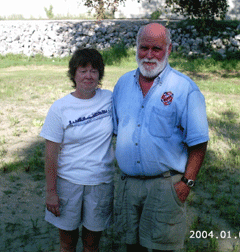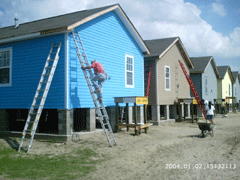Rebuilding Levees, Rebuilding Neighborhoods
Air Date: Week of August 25, 2006

Construction of floodgates and pumps at the 17th St. and London Ave. Canal, August 2006.(Photo: Nancy Allen, USACE)
It's been a year since Hurricane Katrina drowned New Orleans. Now returning residents wonder if the levees that failed in that storm will protect them. Living on Earth's Jeff Young reports on the levee repairs.
Transcript
CURWOOD: This is Living on Earth. I’m Steve Curwood in New Orleans.
[MUSIC: Charlie Miller "Prayer for New Orleans" from ‘Our New Orleans’ (Sony –1929)]
CURWOOD: It’s been a year since Hurricane Katrina rolled through New Orleans. But in many parts of the city you wouldn’t know a year has passed. A year later the high water marks still stain block after block of damaged homes. A year later the deficient floodwalls are still under repair. A year later and it’s almost as if time has stood still.
For Mississippi and Alabama, Katrina was a historic natural disaster—a massive Category 5 hurricane that obliterated the coast. But for New Orleans it was a man-made catastrophe. By the time the storm reached here the winds and surge had weakened to within the design criteria of the levees meant to protect the city. Yet those levees failed on August 29th in the largest civil engineering disaster in American history.

Construction of floodgates and pumps at the 17th St. and London Ave. Canal, August 2006. When the work is completed, five foot diameter pipes will carry rainwater around the floodgates and into Lake Pontchartrain. (Photo: Nancy Allen, USACE)
[HAMMERING]
YOUNG: New Orleans lawyer Jim Cobb tucks a six-pack of beer under each arm as he
checks on his house. The sound of construction is a rare sign of progress in the neighborhood.
COBB: We have floors, we have walls, and paint on the walls. That puts us ahead of 99 percent of people in Lakeview.
[MORE HAMMERING]
YOUNG: The beer is for his workers—with demand for labor so high, he wants to keep them happy. He could use a beer himself. Cobb has the look of someone who’s seen too much and slept too little lately. But what he sees now looks pretty good. The mold and urine-colored stain of high water are gone. Cabinets are going in the kitchen. The house is almost ready for his family of four to return.
COBB: We’ve been here for 10 years. Very happy until August 29, 2005 at about 10:35 a.m. and been unhappy since.
YOUNG: That, of course, was when Hurricane Katrina showed New Orleans just how vulnerable it was. This neighborhood flooded when the eastern levee on the drainage canal along 17th Street failed. Cobb says the past year brought a lot of frustration and pain and little in the way of planning, leadership or financial assistance. He’s eager to get back home, even if it’s to one he hardly recognizes.
COBB: There’s no place to eat, there’s no grocery stores, there’s no pharmacy. We’ve been failed by every level of government for so long that as a citizen you don’t believe anything any of them say. Those of us who are left have decided we’re gonna do it on our own and just give me gas and water and electricity and I’ll see you later.
YOUNG: What’s you’re feeling toward the Army Corps of Engineers now? I mean, your home was resting behind these levees that you obviously had some faith in or you wouldn’t have made the investment in this house here. What do you think of the Army Corps?
COBB: That I can say on the radio? Uh, nothing good. Nothing good.
YOUNG: Well, here you are rebuilding. You’re essentially trusting them to protect you this time around, what’s different?
COBB: What’s different now is that they should be and ought to be horribly humiliated for what they let happen here. And I’m hopeful that they will not let it happen again.
[DEMOLITION SOUND]
YOUNG: The last remnants of homes are still being demolished along the 17th Street canal where the levee failed. Steel pilings block the football-field sized hole in the floodwall and levee.
[SOUND OF CORPS WORK AREA]
YOUNG: Nearby, the canal empties into Lake Pontchartrain. That’s where the Army
Corps is still at work on a dramatic feat of emergency engineering.
HITCHINGS: Yeah, what you see in the farthest distance is what appears to be a big black wall. Those are the gates and when they’re closed they will prevent the water from coming into the canal.

These large pipes will carry rainwater from the 17th street canal around the new floodgate. There are nagging concerns about whether it will be enough to avoid future flooding. (Photo: Nancy Allen, USACE)
HITCHINGS: We’re fearful that if the lake level rose to the point that it would in a severe storm that it would threaten those walls. So those gates will close and it will just keep the water out. The problem that that creates is that when gates are closed they can’t run the pumps to pump the water out of the city.
YOUNG: Because much of New Orleans is below sea level, rainwater must be pumped out. So, just to the sides of the new gates the Corps is installing more pumps and five foot diameter pipes. In a storm, the closed gates would keep surge from entering while the pumps and pipes would let rainwater exit. There are nagging concerns about the pumping capacity. But Hitchings is confident this mix of gates and pumps will keep the city’s drainage canals from causing more catastrophic flooding.
Other levees are being armored with rock or concrete to keep them from eroding if water spills over the top. But there are other problems to deal with. A recent study in the journal Nature showed the land under the entire region is subsiding at a much faster rate than thought. That means many levees are much lower than they should be.
HITCHINGS: So we’ve got 36 miles of floodwalls that over the next two years we’ll be replacing and building a stronger floodwall in their place to provide a higher level of protection than what they currently have. Yeah, if we had an exact repeat of Katrina probably you would see levees overtopped. We wouldn’t have the failures that occurred along these outfall canals. The result would be you’d end up with about one third as much water in this part of the city as you did with Katrina. So it’s still gonna put a lot of water in even if levees did not erode away.
[ENTERING A TRAILER]
YOUNG: K.C. and Kathy King used to have a house right against one of the levees along the London Avenue canal. The levee failed just 8 doors down from them. Now they have a vacant lot with a FEMA trailer and an RV parked on it.
The Kings are among the few people on their quiet, tree-lined drive to rebuild. This time, they’re building higher.

K.C. and Kathy King on the lot where their house stood before the London Avenue Canal levee broke. They plan to build their new home higher than the floodwaters reached—eight feet high. (Photo: Jeff Young)
YOUNG: The government now requires that homes here be three feet above ground level and there’s money to help pay for the construction. But here’s the catch: if you want to go higher, as the Kings do, you have to pay for that extra work yourself. King says it’s worth it because he does not trust the Corps of Engineers.
KING: There’s no evidence they’ve learned and are taking that knowledge and putting it back into reforming the organization, the institution itself. Because that’s what produced it. It wasn’t some disembodied bad decision. It was an institution behaving badly.
YOUNG: King’s not the only one who’d like to see the Corps make some changes. University of California at Berkeley engineering professor Bob Bea was part of a team funded by the National Science Foundation to investigate the levee failures. Bea has praise for the Corps’ work since the storm but scathing criticism for the work that led up to it.
BEA: The Corps is doing, I think, a heroic job to make these intermediate repairs. But if you don’t fix the organizational system that’s responsible for designing constructing operating and maintaining that, you’re not going to win the battle with nature.
YOUNG: Bea brings a unique perspective to both the Corps and the city. He worked for the Corps, as did his father. And Bea lived in New Orleans in 1965 when Hurricane Betsy destroyed his home.
BEA: I looked at this problem ,I think, very, very differently than many of my colleagues and could see very deeply into the eyes of those people that lost so much. I was able to pretty well see what was going on with my old family, the Corps of Engineers, that kept reminding me of how a good family can turn out to not be what we really want.
YOUNG: In short, Bea found his old family, the Corps, had become dysfunctional. He recommends more independent review and oversight of Corps projects and major changes in the way the Corps interacts with Congress, local government sponsors, and industry to set priorities. Major General Don Riley is head of civil engineering for the Army Corps. Riley agrees with most of the technical aspects of Bea’s report on levee failures.
RILEY: Those failed prior to reaching their design height of protection so there’s four engineering failures in particular that we’re highly concerned about. We are certainly accountable for those failures.
YOUNG: What does that mean exactly when you say we’re accountable—have people been fired, demoted, reprimanded in any way?
RILEY: No they haven’t. Now what it means is we’re accountable. We’ll go back and look at all the investigative work that we’ve been doing those reports will come out pretty soon. There’ll be a lot more questions asked and improvements made across the board in all the systems.
YOUNG: Riley says he supports more independent review of Corps work, but he’s less enthusiastic about other recommended changes, saying he sees no need to change the way the Corps works with Congress.
[POWER SAW/CONSTRUCTION NOISE]
YOUNG: In the Upper Ninth Ward of New Orleans, Habitat for Humanity volunteers are working to build, not just new homes but a new neighborhood. They call it the Musicians Village, and Michael Harris will be among its first residents.

The colorful new homes of the Habitat for Humanity Musicians Village project in New Orleans. Musician and father Michael Harris says it’s an answer to his dreams. (Photo: Jeff Young)
HARRIS: I think this is going to be one of the many incubators for our culture and our heritage and tradition. This program is an answer to all my prayers in so many ways and so many levels.
YOUNG: Harris will live in one of the project’s colorful, cozy homes with his teenage son. He’s clearly excited about the new neighborhood, but he’s uneasy about the Corps’ levees and floodwalls that must protect it.
HARRIS: [GROANS, LAUGHS] If I go just by their track record, then it doesn’t look good. Will it flood again? We have the technology to prevent it. We have the technology, that’s proven beyond the shadow of a doubt. Will it be applied? That remains to be seen.
Links
U.S. Army Corps of Engineers – Hurricane Protection System
Interagency Performance Evaluation Taskforce Post-Katrina Report
Levees.org – New Orleans Citizens Group
University of Calif./Berkeley Final Report on New Orleans Flood Protection Systems (July 31, 2006)
Living on Earth wants to hear from you!
Living on Earth
62 Calef Highway, Suite 212
Lee, NH 03861
Telephone: 617-287-4121
E-mail: comments@loe.org
Newsletter [Click here]
Donate to Living on Earth!
Living on Earth is an independent media program and relies entirely on contributions from listeners and institutions supporting public service. Please donate now to preserve an independent environmental voice.
NewsletterLiving on Earth offers a weekly delivery of the show's rundown to your mailbox. Sign up for our newsletter today!
 Sailors For The Sea: Be the change you want to sea.
Sailors For The Sea: Be the change you want to sea.
 The Grantham Foundation for the Protection of the Environment: Committed to protecting and improving the health of the global environment.
The Grantham Foundation for the Protection of the Environment: Committed to protecting and improving the health of the global environment.
 Contribute to Living on Earth and receive, as our gift to you, an archival print of one of Mark Seth Lender's extraordinary wildlife photographs. Follow the link to see Mark's current collection of photographs.
Contribute to Living on Earth and receive, as our gift to you, an archival print of one of Mark Seth Lender's extraordinary wildlife photographs. Follow the link to see Mark's current collection of photographs.
 Buy a signed copy of Mark Seth Lender's book Smeagull the Seagull & support Living on Earth
Buy a signed copy of Mark Seth Lender's book Smeagull the Seagull & support Living on Earth

